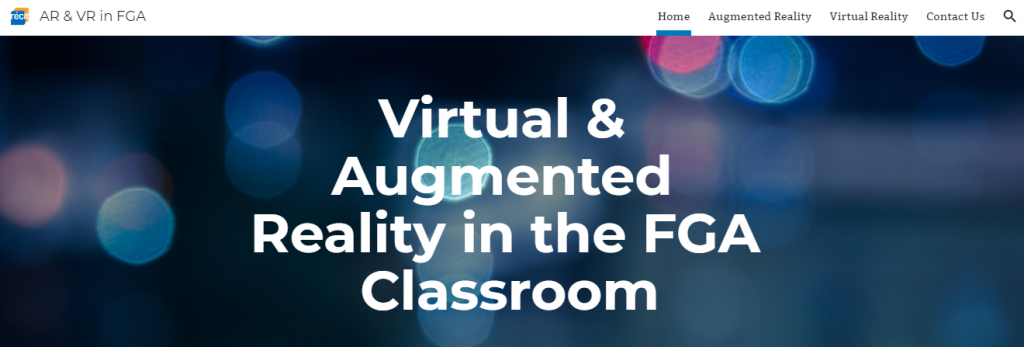What is the difference between Augmented Reality and Virtual Reality?
Augmented Reality (AR) and Virtual Reality (VR) are examples of a growing field of applications that extend reality for the user – at times referred to as Immersive or Extended Reality (xR).
The main difference between these two kinds of xR are in how they extend reality:
AR is when multimedia layers are added onto our actual physical environment. Think of applications that allow you to ‘try on’ a new hair style or pair of glasses. Or to see how a piece of furniture looks in your home.
VR is the creation or experience of imaginary environments, completely disconnected from the physical world around you. You can be standing in your classroom in Montreal while going on a virtual tour of the Rocky Mountains, for example.
Why use AR & VR in FGA?
Although virtual and augmented reality are new technological developments, they provide a multitude of worthwhile possibilities in adult education.
In his article on “Educational Games and Virtual Reality as Disruptive Technologies”, research psychologist Joseph Psotka describes two key benefits to incorporating virtual reality in learning:
- Firstly, these new technologies have the potential for “disrupting traditional educational practice,” addressing the needs of students who struggle with text-based instruction and providing them with creative, innovative, and technology-based learning experiences which will serve them well in the workforce.
- Secondly, the merging of real and virtual spaces can offer “a unique level of educational scaffolding,” as well as “an improved learning-transfer from abstract to concrete domains.”
These tools can help us further student learning – all without having to leave our classrooms!
When should we choose Augmented Reality?
Augmented reality can bring Science and technical course to life in ways that no text book – or even instructional video – can hope to imagine. It allows you and your students to view (or create!) multimedia images as a layer on top of the physical world around you. Imagine aiming your phone’s camera at a skeleton hanging in the corner of your classroom and being able to see all of the structural labels for the skeletal system.
When should we choose Virtual Reality?
We would use VR any time we want to give our students the experience of being somewhere else in order to enhance learning. Imagine its impact on learning in History or Geography when it allows students to go on tours of different areas of the world, or of their own community but 100 years ago.
In Language Arts, it can be an excellent way for a student to explore or construct narrative setting, as well.
More on Virtual and Augmented Reality in Adult Education
This website was created for a workshop on AR and VR in Adult Education and offered by the RECIT for Adult Education regional consultants, Emilie Bowles and Joanne Salvagio, in partnership with RECIT for vocational training, James Burn. Click on the image to visit the site. You can contact them for more info directly from the site.
Tracy Rosen wrote this article based on materials developed for a workshop on AR and VR by Emilie Bowles, James Burn, and Joanne Salvagio, May 2019.
If you would like more information about these resources or if you have something you would like to add to this tile, please contact Tracy Rosen.
All materials are expected to be reused and shared according to this Creative Commons license, unless otherwise noted: CC BY-NC-SA 4.0
 Emilie has been teaching in adult education since 2014. She is currently doing a Masters in Educational Technology at Concordia and recently joined the RECIT network as an ed tech consultant. Find her on Twitter @ebowles_RECIT
Emilie has been teaching in adult education since 2014. She is currently doing a Masters in Educational Technology at Concordia and recently joined the RECIT network as an ed tech consultant. Find her on Twitter @ebowles_RECIT
 Joanne is an educational consultant for Adult Education with the RECIT network in Quebec. She has taught at both the youth and adult sectors and believes in student-centred learning and evidence-based teaching. Find her on Twitter at @SalvagioJoanne
Joanne is an educational consultant for Adult Education with the RECIT network in Quebec. She has taught at both the youth and adult sectors and believes in student-centred learning and evidence-based teaching. Find her on Twitter at @SalvagioJoanne
 James is an educational consultant for Vocational Education with the RECIT network in Quebec. He has a love for teaching and a passion for technology and has been bridging the two in both Adult and Vocational education for a number of years. Find him on Twitter at @jamesburnedu
James is an educational consultant for Vocational Education with the RECIT network in Quebec. He has a love for teaching and a passion for technology and has been bridging the two in both Adult and Vocational education for a number of years. Find him on Twitter at @jamesburnedu

